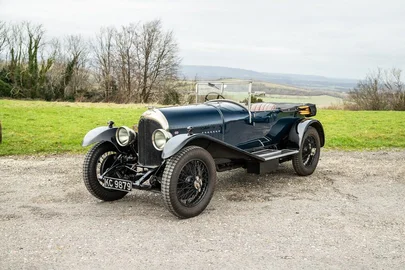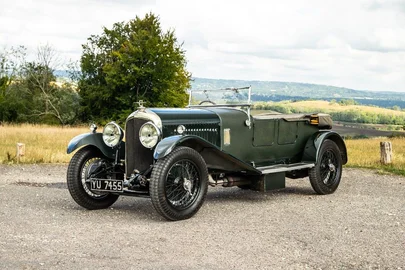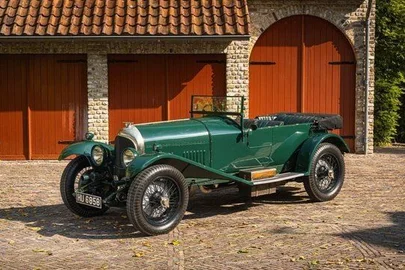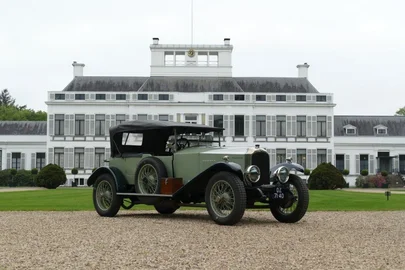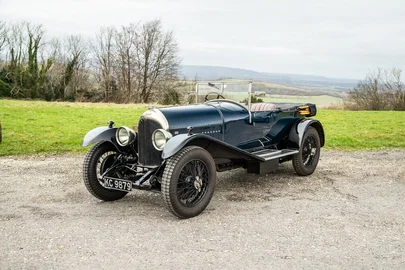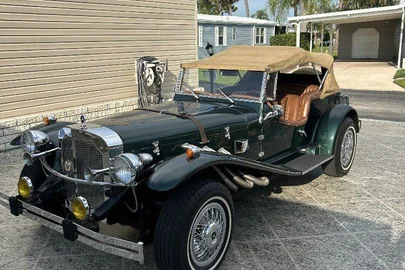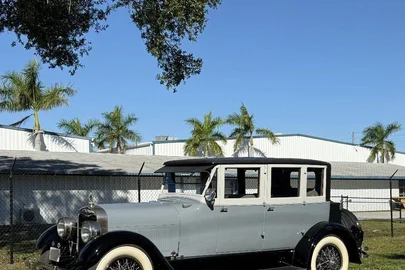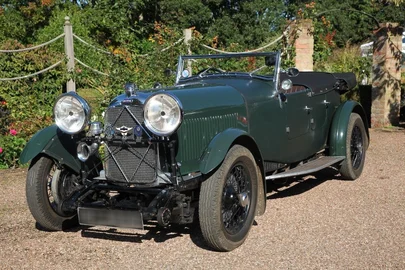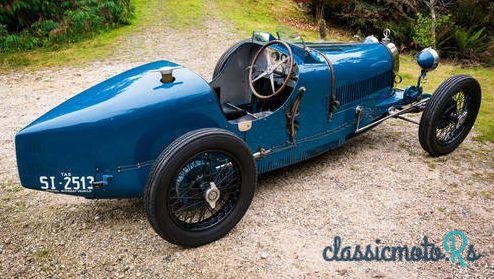
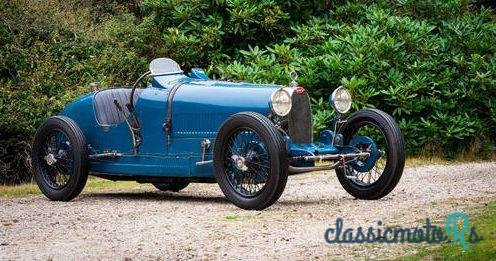
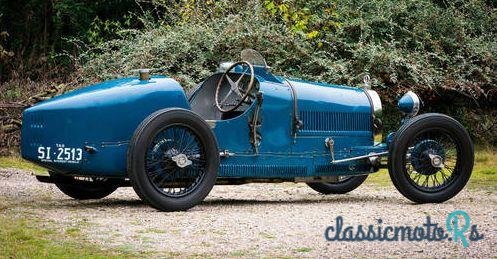
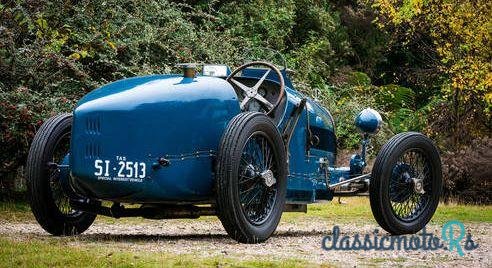
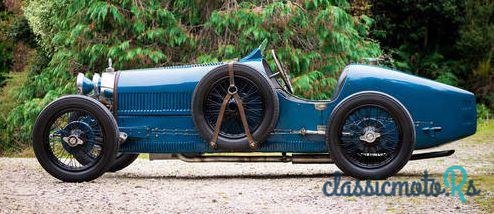
5 фото
1926' Bugatti Type 37
Пожаловаться!Оценить!Запомнить это
Возможен торгОпубликовано 4 июля 2017ID: Zff8uX
Истекло
8 лет, 5 месяцев назад
8 лет, 5 месяцев назад
Information from the owner
Возраст: 91 год
Комментарии продавца про 1926' Bugatti Type 37
ESTIMATE £400,000-£600,000
Blenheim Palace July 2017
LOT DETAILS
Lot Number 158
Chassis Number 37140
Year 1926
Make Bugatti
Model Type 37
DESCRIPTION
At the end of the 1925 season the CSI (Commission Sportive Internationale) introduced a new formula intended to slow down the then current generation of 2-litre Grand Prix cars, imposing a 1.5-litre capacity limit for 1926. The Bugatti Type 37 was introduced in November 1925, proving to be one of the most iconic and instantly recognizable racing cars to ever leave Ettore Bugatti's facilities in Molsheim, France. Like its predecessor, the Type 35, the Type 37 provided all the performance that one desired, yet it also offered an excellent level of practicality for road-based events and rallies. However, as opposed to the eight-cylinder unit found in the Type 35, the Type 37 was fitted with a four-cylinder engine - considered by many to be more reliable, yet it also provided just as much excitement to the individual behind the wheel as its bigger brother did. Not only could the Type 37 be driven hard all day long, but it also proved reliable enough to be driven home at the end of the day under its own power, even with an additional passenger riding along.
The Type 37's chassis and body were very similar to those of the 2-litre Type 35, the two models looking almost identical. In most respects the engine was typically Bugatti, the iron block and head being one casting topped by a single bevel-driven camshaft operating three valves per cylinder: two inlet and one exhaust. However, for the Type 37's crankshaft Ettore Bugatti opted for plain big-end and main bearings rather than the Type 35's ball/roller combination. A maximum power output of 60bhp was claimed, which was good enough for a top speed of around 95mph.
Compared to its larger eight-cylinder siblings, the Type 37 relies on mechanical simplicity, finesse, and lightweight design for its performance, rather than the over-engineered brute force that was more typical in racing cars of the period. With a compact yet powerful 1.5-liter engine, the Type 37 was easily capable of 90 mph. Braking was also effective, and the whole package was quickly identified as a race-winning car for any serious driver on the international racing scene.
It comes as little surprise then that in 1926 Richard Twelvetrees of Motor Sport described the Type 37 thus, '(In) the 1,500cc Grand Prix Bugatti... the manufacturers have introduced a new era for the sporting motorist by placing a real production racing car in the hands of the public... One of these machines... as delivered... will be fit to win races and competitions without any need of "hotting up".'
The Type 37, like its predecessor, the Type 35, is for many collectors the ultimate embodiment of a high-performance and competitive racing car, yet also one which offers enthusiasts an excellent level of practicality for road-based events and rallies.
The wide cockpit offers genuine two-seat accommodation for the driver and a companion, making it a wonderful choice for any driver holding the romantic notion that a car should be driven to a circuit, raced competitively, and then driven home.
One of three Type 37s which world speed record holder and London Bugatti dealer Malcolm Campbell purchased from the works in the Spring of 1926, chassis 37140 was registered on 17th April of with the number plate YP 9663. A year later the Type 37 was owned by W. B. Scott (Bummer to his friends), a regular competitor at Brooklands and very well known in the racing scene at the time. Scott is believed to have raced the Type 37 at Brooklands in 1927 before concentrating on his Grand Prix Sunbeam for the 1928 season.
Chassis 37140 passed hands a few times over the coming years before being purchased by R. MacLeod-Carey in 1934. During his ownership Macleod-Carey invested in several modifications to improve the performance of the Type 37; amongst which a supercharger was mounted on the engine, as were four AMAC motorcycle carburettors, an extractor exhaust manifold was fitted, the ignition upgraded to magnetos, and the suspension uprated with telescopic shock absorbers. Macleod-Carey kept a 150 page note book containing hand drawings and typed accounts of his modifications and exploits with the car from 1934 to 1940.
In 1940 MacLeod-Carey sold the car to Mr. Dudley Gahagan, who owned the Type 37 for a somewhat incredible 57 years before bequeathing the car to the current vendor in 1997.
Gahagan was well established in the classic car world, being involved in the early days of the VSCC, and running the classic restoration business Rees Brothers of Aldershot in Hampshire for many years (and indeed still in business today). When not restoring or repairing older motor cars, Gahagan would be actively campaigning his beloved Type 37 at numerous hill climbs, time and speed trials, and embarking on various continental trips. Gahagan participated in the Prescott Hill Climb several times from 1948 to 1960, at Goodwood, several times at the Brighton Speed Trials, and at the newly created Silverstone track on over 20 occasions from 1949 through to 1992.
The Type 37 enjoyed a well earned comprehensive restoration from 2002 to 2008, and since has been used sparingly. In the last 12 months the engine has been rebuilt from a replacement block (the original numbers matching block is offered with 37140), and fitted with a forged crankshaft, full pressure oil pump, forged piston and modern con rods. Notably the Type 37 is also still offered with its original chassis, gearbox, and both front and rear axles.
Supplied with current and older buff-style registration documents, and a number of original spare mechanical components (a full list available upon request), this is a well known example of one of the most iconic cars of the last century, one which presents a unique opportunity for the serious collector.
Blenheim Palace July 2017
LOT DETAILS
Lot Number 158
Chassis Number 37140
Year 1926
Make Bugatti
Model Type 37
DESCRIPTION
At the end of the 1925 season the CSI (Commission Sportive Internationale) introduced a new formula intended to slow down the then current generation of 2-litre Grand Prix cars, imposing a 1.5-litre capacity limit for 1926. The Bugatti Type 37 was introduced in November 1925, proving to be one of the most iconic and instantly recognizable racing cars to ever leave Ettore Bugatti's facilities in Molsheim, France. Like its predecessor, the Type 35, the Type 37 provided all the performance that one desired, yet it also offered an excellent level of practicality for road-based events and rallies. However, as opposed to the eight-cylinder unit found in the Type 35, the Type 37 was fitted with a four-cylinder engine - considered by many to be more reliable, yet it also provided just as much excitement to the individual behind the wheel as its bigger brother did. Not only could the Type 37 be driven hard all day long, but it also proved reliable enough to be driven home at the end of the day under its own power, even with an additional passenger riding along.
The Type 37's chassis and body were very similar to those of the 2-litre Type 35, the two models looking almost identical. In most respects the engine was typically Bugatti, the iron block and head being one casting topped by a single bevel-driven camshaft operating three valves per cylinder: two inlet and one exhaust. However, for the Type 37's crankshaft Ettore Bugatti opted for plain big-end and main bearings rather than the Type 35's ball/roller combination. A maximum power output of 60bhp was claimed, which was good enough for a top speed of around 95mph.
Compared to its larger eight-cylinder siblings, the Type 37 relies on mechanical simplicity, finesse, and lightweight design for its performance, rather than the over-engineered brute force that was more typical in racing cars of the period. With a compact yet powerful 1.5-liter engine, the Type 37 was easily capable of 90 mph. Braking was also effective, and the whole package was quickly identified as a race-winning car for any serious driver on the international racing scene.
It comes as little surprise then that in 1926 Richard Twelvetrees of Motor Sport described the Type 37 thus, '(In) the 1,500cc Grand Prix Bugatti... the manufacturers have introduced a new era for the sporting motorist by placing a real production racing car in the hands of the public... One of these machines... as delivered... will be fit to win races and competitions without any need of "hotting up".'
The Type 37, like its predecessor, the Type 35, is for many collectors the ultimate embodiment of a high-performance and competitive racing car, yet also one which offers enthusiasts an excellent level of practicality for road-based events and rallies.
The wide cockpit offers genuine two-seat accommodation for the driver and a companion, making it a wonderful choice for any driver holding the romantic notion that a car should be driven to a circuit, raced competitively, and then driven home.
One of three Type 37s which world speed record holder and London Bugatti dealer Malcolm Campbell purchased from the works in the Spring of 1926, chassis 37140 was registered on 17th April of with the number plate YP 9663. A year later the Type 37 was owned by W. B. Scott (Bummer to his friends), a regular competitor at Brooklands and very well known in the racing scene at the time. Scott is believed to have raced the Type 37 at Brooklands in 1927 before concentrating on his Grand Prix Sunbeam for the 1928 season.
Chassis 37140 passed hands a few times over the coming years before being purchased by R. MacLeod-Carey in 1934. During his ownership Macleod-Carey invested in several modifications to improve the performance of the Type 37; amongst which a supercharger was mounted on the engine, as were four AMAC motorcycle carburettors, an extractor exhaust manifold was fitted, the ignition upgraded to magnetos, and the suspension uprated with telescopic shock absorbers. Macleod-Carey kept a 150 page note book containing hand drawings and typed accounts of his modifications and exploits with the car from 1934 to 1940.
In 1940 MacLeod-Carey sold the car to Mr. Dudley Gahagan, who owned the Type 37 for a somewhat incredible 57 years before bequeathing the car to the current vendor in 1997.
Gahagan was well established in the classic car world, being involved in the early days of the VSCC, and running the classic restoration business Rees Brothers of Aldershot in Hampshire for many years (and indeed still in business today). When not restoring or repairing older motor cars, Gahagan would be actively campaigning his beloved Type 37 at numerous hill climbs, time and speed trials, and embarking on various continental trips. Gahagan participated in the Prescott Hill Climb several times from 1948 to 1960, at Goodwood, several times at the Brighton Speed Trials, and at the newly created Silverstone track on over 20 occasions from 1949 through to 1992.
The Type 37 enjoyed a well earned comprehensive restoration from 2002 to 2008, and since has been used sparingly. In the last 12 months the engine has been rebuilt from a replacement block (the original numbers matching block is offered with 37140), and fitted with a forged crankshaft, full pressure oil pump, forged piston and modern con rods. Notably the Type 37 is also still offered with its original chassis, gearbox, and both front and rear axles.
Supplied with current and older buff-style registration documents, and a number of original spare mechanical components (a full list available upon request), this is a well known example of one of the most iconic cars of the last century, one which presents a unique opportunity for the serious collector.
